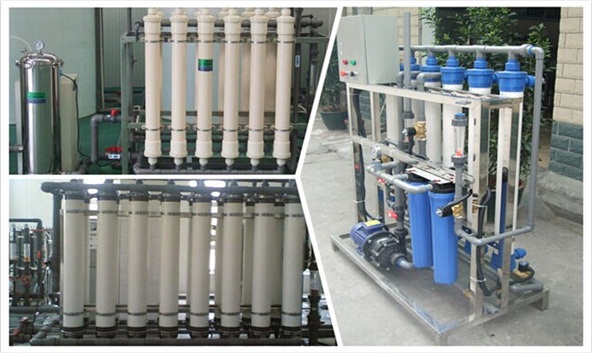- Durable standards
- Efficient functioning
- Require less maintenance
GWS engineers design and build tailor-made ultrafiltration plants.
Our UF plants are build with hollow fiber outside-in membranes, up to 100 m3/h, to purify surface or groundwater from suspended solids, colloids and all kind of micro-organisms such as bacteria, virus, protozoa, germs and larvae.
Ultrafiltration is also commonly use as a Reverse Osmosis plant pretreatment
Ultrafiltration (UF) is a variety of membrane filtration in which forces like pressure or concentration gradients lead to a separation through a semipermeable membrane. Suspended solids and solutes of high molecular weight are retained in the so-called retentate, while water and low molecular weight solutes pass through the membrane in the permeate (filtrate). This separation process is used in industry and research for purifying and concentrating macromolecular (103 - 106 Da) solutions, especially protein solutions. Ultrafiltration is not fundamentally different from microfiltration. Both of these separate based on size exclusion or particle capture. It is fundamentally different from membrane gas separation, which separate based on different amounts of absorption and different rates of diffusion. Ultrafiltration membranes are defined by the molecular weight cut-off (MWCO) of the membrane used. Ultrafiltration is applied in cross-flow or dead-end mode. UF can be used for the removal of particulates and macromolecules from raw water to produce potable water. It has been used to either replace existing secondary (coagulation, flocculation, sedimentation) and tertiary filtration (sand filtration and chlorination) systems employed in water treatment plants or as standalone systems in isolated regions with growing populations. When treating water with high suspended solids, UF is often integrated into the process, utilising primary (screening, flotation, filtration) and some secondary treatments as pre-treatment stages. UF processes are currently preferred over traditional treatment methods for the following reasons:- No chemicals required (aside from cleaning)
- Constant product quality regardless of feed quality
- Compact plant size
- Capable of exceeding regulatory standards of water quality, achieving 90-100% pathogen removal.
- UF processes are currently limited by the high cost incurred due to membrane fouling and replacement. Additional pretreatment of feed water is required to prevent excessive damage to the membrane units.
In many cases UF is used for pre filtration in reverse osmosis (RO) plants to protect the RO membranes.
Protein concentration.UF is used extensively in the dairy industry; particularly in the processing of cheese whey to obtain whey protein concentrate (WPC) and lactose-rich permeate. In a single stage, a UF process is able to concentrate the whey 10-30 times the feed. The original alternative to membrane filtration of whey was using steam heating followed by drum drying or spray drying. The product of these methods had limited applications due to its granulated texture and insolubility. Existing methods also had inconsistent product composition, high capital and operating costs and due to the excessive heat used in drying would often denature some of the proteins. Compared to traditional methods, UF processes used for this application:
Are more energy efficient- Have consistent product quality, 35-80% protein product depending on operating conditions.
- Do not denature proteins as they use moderate operating conditions.
The potential for fouling is widely discussed, being identified as a significant contributor to decline in productivity. Cheese whey contains high concentrations of calcium phosphate which can potentially lead to scale deposits on the membrane surface. As a result substantial pretreatment must be implemented to balance pH and temperature of the feed to maintain solubility of calcium salts.
A selectively permeable membrane can be mounted in a centrifuge tube. The buffer is forced through the membrane by centrifugation, leaving the protein in the upper chamber.
Other applications
- Filtration of effluent from paper pulp mill
- Cheese manufacture, see ultrafiltered milk
- Removal of pathogens from milk
- Process and waste water treatment
- Enzyme recovery
- Fruit juice concentration and clarification
- Dialysis and other blood treatments
- Desalting and solvent-exchange of proteins (via diafiltration)
- Laboratory grade manufacturing

